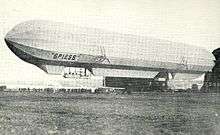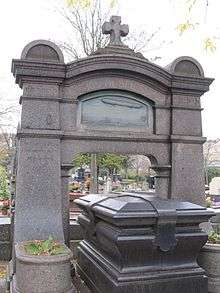Joseph Spiess
Joseph Spiess (10 September 1838[1] – 31 March 1917[2]) was a French engineer who filed a patent for a rigid airship in 1873, the year before Ferdinand von Zeppelin first outlined his own design. However, Spiess's machine was not actually constructed until 1913, and was the first and only French rigid airship.
Biography
Spiess was the son of a printer, in Mulhouse, Haut-Rhin département, in the Alsace region of France.[3] He served as a warrant officer in the Franco-Prussian War from 1870 to 1871,[4] and when Alsace-Lorraine was annexed by the German Empire, Spiess opted to retain his French nationality.[5]

Shortly before World War I, there was public pressure for France to emulate Germany's airship fleet,[6] and construction of Spiess's airship, with state assistance, was started by Société Zodiac at the Aérodrome de Saint-Cyr-l'École.[7] It had a framework of hollow wooden spars braced with wire, and was given the name Zodiac XII but had the name "SPIESS" painted along the side of the envelope.[8] It was 113 metres long, with a diameter of 13.5 metres, powered by a single Chenu 200 horse power engine that drove two propellers. It first flew on April 13, 1913, but it became clear that it was underpowered and required more lift, so the envelope was extended to 140 metres to accommodate three more gas cells and a second engine was added. Spiess then presented the airship to the French government as a gift.[9] After further trials, it was not accepted by the French military, because their view was smaller non-rigid types would be more effective.[10] The Spiess airship seems to have been broken up in 1914.
.jpg)
The first appearance of the Spiess airship over Paris initially caused consternation as it was mistaken for a German Zeppelin; however, when it was found to be a French machine, Spiess became something of a national celebrity and was nominated for Chevalier of the Légion d'Honneur in June 1913.[11]

Joseph Spiess is buried with other family members in the Cimetiere du Pere-Lachaise in Paris; his gravestone has a bronze frieze depicting his airship.[12]
References
- Archives Nationales - Dossier: LH/2546/5 SPIESS Joseph 10/09/1939 (p.4/15)
- Dossier: LH/2546/5 (p.1/15)
- Archives Nationales - Dossier: LH/2546/5 SPIESS Joseph 10/09/1939 (p.4/15)
- Dossier: LH/2546/5 (p.15/15)
- Dossier: LH/2546/5 (p.6/15)
- Frederick A. Talbot, Aeroplanes and Dirigibles of War, The Echo Library 2006, ISBN 1-40680-763-X (p.20)
- EntreVoisins: Birthplace of the first rigid frame airship
- Jane's All the World's Aircraft 1913 "Zodiac XII" (p.125)
- Ladislas d'Orcy, D'Orcy's Airship Manual, The Century Co. N.Y. 1917
- Global Security: French Airships / Dirigeable - The Great War
- Dossier: LH/2546/5 (p.12/15)
- Aérostèles: Tomb of Joseph Spiess